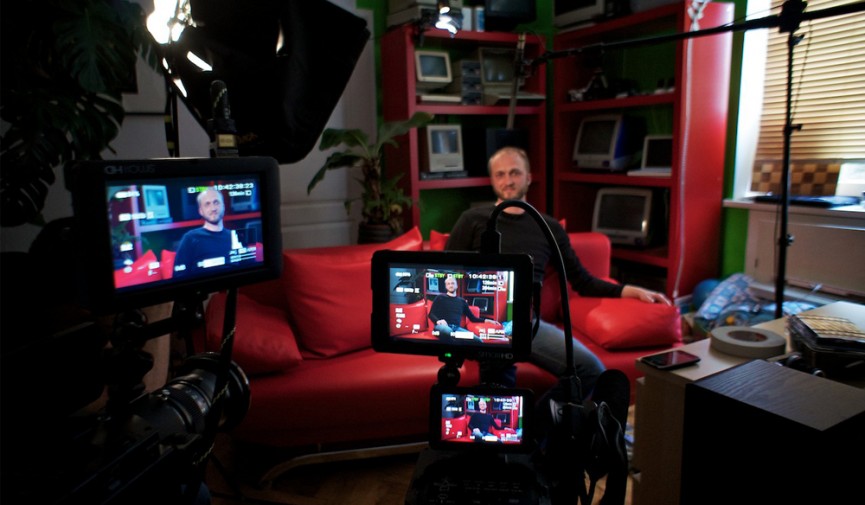Corporate video demands a certain look and approach. Let’s take a good look at the best lenses for corporate video interviews.
Top Image via Peter P Soup
As videographers and filmmakers, we have to be keenly aware of what the day’s production requires in terms of gear. This is especially true for interviews and the lenses used to capture them, no matter if the project is narrative, commercial or industrial.
The difference between a documentary interview for a narrative film and a corporate interview is minimal at best. With this said, most documentary filmmakers and videographers run a two camera setup. However, you may not be able to do that, so we’ll be sure to go through an easy solution for a single camera setup before we go into the lens options for a two camera setup.
Before we get started, let’s look at this example of solid corporate interview composition that comes from an Apple corporate video.
Video via EveryAppleVideo
Single Camera Setup
 Image via WordStream
For single camera setups, you can do one of two things. The first being that you use one single prime lens, probably a 50mm Prime lens. Your second option, and potentially best option, would be to use a zoom lens like the Canon 70-200mm. Now, both options will require quality lighting of the subject and framing, but beyond that, let’s look at why we picked these two lenses.
Image via WordStream
For single camera setups, you can do one of two things. The first being that you use one single prime lens, probably a 50mm Prime lens. Your second option, and potentially best option, would be to use a zoom lens like the Canon 70-200mm. Now, both options will require quality lighting of the subject and framing, but beyond that, let’s look at why we picked these two lenses.

50mm Prime

No lens can simulate the human eye better than the 50mm Prime. When you’re regulated to just one camera, and you want to make sure that the interview you’re capturing looks fantastic, you’ll need to use a 50mm lens.
This particular lens will offer you the best options in terms of sharpness of the image. If you set your camera up correctly, you’ll get a shot with great depth of field. Also remember you can move your camera closer or further away from your subject in order to capture varying compositions.
70-200mm Zoom
If you don’t have the space needed to move your camera between closer and farther away from the subject, then you’ll want to utilize a zoom lens. For this we suggest a Canon 70-200mm, but know there are other quality options out there. By using this zoom lens you can frame your wider shot by setting the lens to 70mm. Then, when you need to go closeup, you make that adjustment by moving closer to toward 200mm. This option can be a time saver, and you’ll find that, for interviews, a zoom lens like the 70-200mm looks fantastic.
Two Camera Setup

Image via DGA Photoshop
Most professionals prefer a two camera setup. When running two cameras, what you’ll usually find is that A Camera will remain on the sticks as a static shot, while B Camera can either be on sticks, on a slider, or on a Steadicam. The B Camera lets you capture additional dynamic information, such a hands moving while the subject is talking or getting in close to frame their eyes. Let’s look at two different lens pairings for the two camera setup.
Prime Lenses
Prime Lenses
Image via Bert Lighting House
The first pairing is pretty straight forward; you use two prime lenses. Many times you’ll see videographers or documentary filmmakers use a combination of a 50mm and an 85mm Prime lens. What happens here is that A Camera gets the 50mm to capture that great looking master shot, then you supplement this by using the 85mm Prime with B Camera to capture much tighter shot.
B Camera then usually becomes the camera of movement. By using the 85mm and adjusting our camera setting correctly, we can capture nice dolly shots or tracking shots that will have a parallax effect.
Using a Prime and a Zoom
Image via Maximum Impact Photography
For the second pairing, we’ll just take the two main options for the single camera setup and combine them together. So, in this case, we’ll again run the 50mm lens on A Camera, but now we’ll place a zoom lens like the 70-200mm on B Camera. Essentially what we are doing is exactly what we did above with the two Prime lens pairing — but by using a zoom lens, B Camera has a ton of flexibility in terms of framing.
Any of the lens setups above will work for your next corporate video interview, just be sure to do whatever is comfortable. Above all else, your interview is the most important, so be sure to capture it as best you can with what you have.
Was this rundown helpful to you? Have any of these lens options worked well for you? Do you have a specific lens not listed that you enjoy using for interviews? Tell us all about it in the comments below.
Originally posted in Premiumbeat blog.
Originally posted in Premiumbeat blog.



